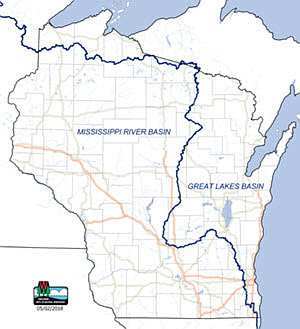
The Great Lakes Compact is a formal agreement between the Great Lakes states which details how the states will work together to manage and protect the Great Lakes-St. Lawrence River Basin. A parallel agreement (the Sustainable Water Resources Agreement) includes Ontario and Québec, the two Canadian provinces that border the Great Lakes and the St. Lawrence Seaway. Through these agreements, the states and provinces collectively manage Great Lakes water.

The Great Lakes Compact became effective on Dec. 8, 2008, after final consent from the U.S. Congress [PDF exit DNR] . This date began the ban on diversions of water out of the basin, with limited exceptions. To implement the compact, Wisconsin passed implementing legislation [PDF exit DNR] in 2008 and has an active management program.
Two regional organizations oversee the implementation of the compact and the parallel agreement with the provinces.
Several landowners and public water supply systems transferred water from the Great Lakes basin to the Mississippi River basin prior to 2008 (the year the Great Lakes Compact and Agreement were ratified). The DNR issued approvals to these entities and recognize them as “pre-existing” diversions.”
However, the Great Lakes Compact and Agreement ban diversions of Great Lakes water with limited exceptions. These exceptions allow a "straddling community" or "community in a straddling county" to submit an application to the DNR to divert water (i.e., to move water out of the Great Lakes Basin).
Wisconsin’s pre-existing and existing diversion approvals are as follows:
| Name of Diversion | County | Approved Diversion Volume (gallons per day) | Type of Diversion* |
|---|---|---|---|
| Village of Bristol | Kenosha | 1,380,000 | Pre-existing |
| City of Brookfield | Waukesha | 1,944,000 | Pre-existing |
| K&K Farms, Inc. | Waushara | 783,360 | Pre-existing |
| City of Kenosha | Kenosha | 2,540,000 | Pre-existing |
| Lepak | Portage | 123,600 | Pre-existing |
| Village of Menomonee Falls | Waukesha | 3,217,200 | Pre-existing |
| City of New Berlin | Waukesha | 2,142,000 | Straddling Community |
| Village of Pardeeville | Columbia | 347,600 | Pre-existing |
| Village of Pleasant Prairie | Kenosha | 10,690,000 | Pre-existing |
| City of Portage | Columbia | 9,580,000 | Pre-existing |
| City of Racine | Racine | 7,000,000 | Straddling Community |
| Village of Somers | Kenosha | 1,200,000 | Straddling Community |
| Southern Wisconsin Center | Racine | 836,000 | Pre-existing |
| City of Waukesha | Waukesha | 8,200,000 | Community in a Straddling County |
| Shanrod Farms, LLC | Racine | 4,000 | Pre-existing |
| Kettle Hills Golf Course | Washington | 112,034 | Pre-existing |
* Pre-existing diversion means an interbasin transfer approved under s. 281.344(3m) and (4), Wis. Stats., of water from the Great Lakes basin into a watershed outside of the Great Lakes basin that existed prior to the ratification of the Great Lakes Compact on December 8, 2008.
This table summarizes diversion application requirements for a "straddling community" or "community in a straddling county."